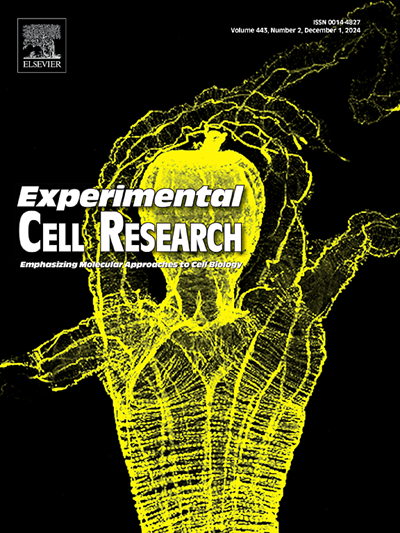转录因子间充质同源盒1通过结缔组织生长因子的转录激活加剧肝纤维化。
IF 3.3
3区 生物学
Q3 CELL BIOLOGY
引用次数: 0
摘要
肝纤维化是一种慢性疾病,具有多种病因的特点,其发病的关键事件是静止的肝星状细胞(hsc)活化成肌成纤维细胞。间充质同源盒1 (Mesenchyme homeobox 1, MEOX1)是细胞发育和分化的重要转录因子。然而,MEOX1信号在肝纤维化中的作用在很大程度上仍然未知。在本研究中,我们通过体内和体外不同模型探讨了MEOX1在肝纤维化中的潜在作用和机制。通过生物信息学分析确定,MEOX1在非酒精性脂肪性肝炎(NASH)患者的肝脏表达与纤维化程度呈正相关。此外,MEOX1在蛋氨酸和胆碱缺乏饮食(MCD)、硫代乙酰胺(TAA)或四氯化碳(CCl4)处理的C57/BL6小鼠的活化hsc和纤维化肝组织中表现出高表达水平。在机制上,MEOX1促进了HSC的激活、增殖和迁移。综合分析转录组测序和染色质免疫沉淀测序数据,发现结缔组织生长因子(CTGF)是造血干细胞中MEOX1的靶基因。具体而言,MEOX1结合到CTGF的启动子区域,增强其转录活性,从而介导MEOX1对肝纤维化的加重作用。总之,我们目前的研究结果阐明了MEOX1通过CTGF的转录激活在加剧肝纤维化进程中的作用。我们的发现为靶向MEOX1治疗肝纤维化的治疗潜力提供了有价值的见解。本文章由计算机程序翻译,如有差异,请以英文原文为准。
The transcription factor mesenchyme homeobox 1 exacerbates hepatic fibrosis by transcriptional activation of connective tissue growth factor
As a chronic condition, liver fibrosis is characterized by diverse etiological factors, and the pivotal event to its pathogenesis is the activation of quiescent hepatic stellate cells (HSCs) into myofibroblasts. Mesenchyme homeobox 1 (MEOX1) is a transcription factors central to cellular development and differentiation. However, the role of MEOX1 signaling in hepatic fibrosis still remains largely unknown. In this study, we investigated the potential role and mechanism of MEOX1 in liver fibrosis using different models in vivo and in vitro. The hepatic expression of MEOX1 exhibited a positive correlation with the degree of fibrosis in patients diagnosed with non-alcoholic steatohepatitis (NASH), as determined through bioinformatics analysis. Furthermore, MEOX1 demonstrated high expression levels in activated HSCs and fibrotic liver tissues induced by methionine and choline-deficient diet (MCD), thioacetamide (TAA), or carbon tetrachloride (CCl4) treatment in C57/BL6 mice. Mechanistically, MEOX1 facilitated HSC activation, proliferation, and migration. The comprehensive analysis of transcriptome sequencing and chromatin immunoprecipitation sequencing data revealed that connective tissue growth factor (CTGF) served as a target gene for MEOX1 in HSCs. Specifically, MEOX1 bound to the promoter region of CTGF and enhanced its transcriptional activity, thereby mediating the exacerbating effect of MEOX1 on hepatic fibrosis. In conclusion, our current findings elucidate the role of MEOX1 in exacerbating hepatic fibrosis progression through transcriptional activation of CTGF. Our findings provide valuable insights into the therapeutic potential of targeting MEOX1 for the treatment of hepatic fibrosis.
求助全文
通过发布文献求助,成功后即可免费获取论文全文。
去求助
来源期刊

Experimental cell research
医学-细胞生物学
CiteScore
7.20
自引率
0.00%
发文量
295
审稿时长
30 days
期刊介绍:
Our scope includes but is not limited to areas such as: Chromosome biology; Chromatin and epigenetics; DNA repair; Gene regulation; Nuclear import-export; RNA processing; Non-coding RNAs; Organelle biology; The cytoskeleton; Intracellular trafficking; Cell-cell and cell-matrix interactions; Cell motility and migration; Cell proliferation; Cellular differentiation; Signal transduction; Programmed cell death.
 求助内容:
求助内容: 应助结果提醒方式:
应助结果提醒方式:


